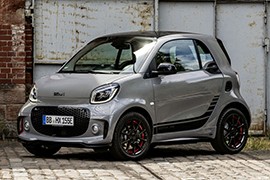Body style: Hatchback
Segment: Mini
Production years: 2019, 2020, 2021, 2022, 2023, 2024
 19 Photos
19 PhotosIn 2019, Mercedes-Benz re-badged the brand Smart, which was now focused on electric vehicles, and thus created the smart-EQ, which was available as a two-door coupe or a convertible.
Mercedes-Benz worked with the French automaker Renault when it made the third generation of the smart fortwo, launched in 2014. Fast forward three years, and the electric versions of this city car got rebranded and received the EQ badge behind the brand’s name, following the same system introduced by the three-pointed star automaker for its electric vehicles. Only a year later, in the autumn of 2019, the new smart-EQ received a facelift for both its fortwo coupe and fortwo cabriolet versions. In addition, the automaker pulled the plug on the ICE versions for the entire range, including the fourfour. Thus, the brand returned to its original idea of an all-electric vehicle made for the urban environment.
At the front, the car sported a smiling-shaped lower grille flanked on the sides by scoops and the optional fog lamps. In addition, the headlights got a slight reshape and integrated daytime running lights, which surrounded the inner sides of the headlamps. Starting with the 2019 fortwo, the car also got LED lights that improved the nighttime driving experience and lowered the energy consumption compared to halogen or Xenon bulbs. From its profile, the fortwo featured a steep windshield and a short roof. Behind the thick B-pillars, the automaker installed the vertical tailgate, adorned on its upper side by plastic trims and a roof spoiler.
The cabin was refreshed compared to the 2016 model and featured tall seatbacks with integrated headrests. Fronting the driver was a classic smart instrument cluster with a TFT display surrounded by an analog dial for the speedometer. Mercedes-Benz added a new infotainment unit on the center stack, supporting Bluetooth connectivity. The standard version came well-equipped and included AC and heated seats. Underneath it, on the center console, the automaker placed the gear selector, two cup holders, and a tiny drawer on the side for some coins or headphones. Behind the tiny cabin was a briefcase-sized trunk placed above the rear axle and the electric motor.
Mercedes-Benz installed a 60 kW (80 HP) behind the car, under the trunk’s floor. Thanks to its instant torque of 160 Nm (118 lb-ft.), the car could accelerate quickly to keep pace with other vehicles in urban traffic. Despite its small size, the car had a 17.6 kWh lithium-ion battery pack installed under the floor. Thanks to its light construction and small size, the smart EQ fortwo could rocket from 0 to 60 kph (45 MPH) in less than five seconds. In addition, the energy-efficient motor with regenerative braking could provide a range of 156 km (99 miles) on a single charge.
SMART EQ fortwo 2019, 2020, 2021, 2022, 2023, 2024
- 41 Kw (82 HP)
SMART EQ fortwo
41 Kw (82 HP)
ENGINE SPECS - 41 Kw (82 HP) | |
|---|---|
| Power: | 60 KW @ - RPM 81.6 HP @ - RPM 80 BHP @ - RPM |
| Torque: | 118 lb-ft @ - RPM 160 Nm @ - RPM |
| Fuel System: | Electric |
| Fuel: | Electric |
PERFORMANCE SPECS | |
|---|---|
| Top Speed: | 81 mph (130 km/h) |
| Acceleration 0-62 Mph (0-100 kph): | 11.6 s |
TRANSMISSION SPECS | |
|---|---|
| Drive Type: | Rear Wheel Drive |
BRAKES SPECS | |
|---|---|
| Front: | Ventilated Discs |
| Rear: | Discs |
DIMENSIONS | |
|---|---|
| Length: | 105.9 in (2690 mm) |
| Width: | 65.4 in (1661 mm) |
| Height: | 61 in (1549 mm) |
| Front/rear Track: | 57.8/56.3 in (1,468/1,430 mm) |
| Wheelbase: | 73.7 in (1872 mm) |
| Ground Clearance: | 5.2 in (132 mm) |
| Cargo Volume: | 9.2 cuFT (261 L) |
| Aerodynamics (Cd): | 0.38 |
POWER SYSTEM SPECS | |
|---|---|
| Range: | 92 miles (148.1 km) |
| Notes |
|---|
| Combined power consumption (kWh/100 km), 4.6 kW on-board charger: 16.5-15.2 kWh Combined power consumption (kWh/100 km), 22 kW on-board charger: 15.2-14.0 KWh |


















